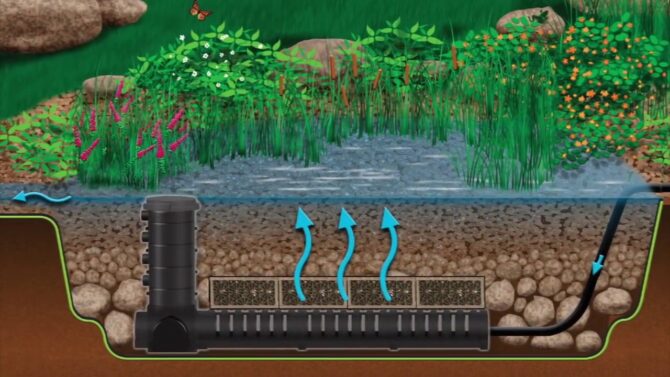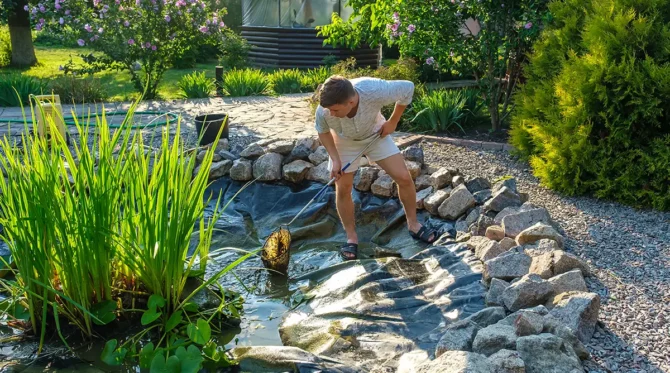Owning a pond can be one of the most relaxing and enjoyable ways to connect with nature right in your own backyard. But to keep your pond beautiful and healthy, maintaining water quality is key. When it comes to fish care, poor water conditions can turn your peaceful sanctuary into a stressful place for both you and your finned friends.
So, let’s dive straight into how to ensure that your pond stays clear and your fish remain happy.
Key Points
- Clean water is crucial for a healthy pond.
- Filtration systems are essential for maintaining water quality.
- Plants help keep water clear.
- Fish waste management is important.
- Regular testing of water parameters ensures balance.
Regular Pond Maintenance for Clear Water
Maintaining your pond is like treating it to a little spa day. A clean pond means happy fish, healthy plants, and a beautiful space for you to enjoy. It’s not just about appearance; it’s about keeping the whole environment balanced and thriving. Good pond maintenance also prevents issues before they start. Need professional help? You can check out services like That Pond Guy to keep everything running smoothly.
The Role of a Good Filtration System
Imagine your pond as a tiny ecosystem. Just like a house needs a good cleaning routine, a pond relies on a filtration system to stay clean. Filtration systems remove debris, excess nutrients, and waste from fish. Without this, water can turn cloudy, leading to stress for your fish. There are two types of filtration systems you need to know about mechanical and biological.
Mechanical filters trap solid waste and debris. Leaves, twigs, and uneaten fish food don’t stand a chance with these. Biological filters, on the other hand, break down harmful chemicals like ammonia that come from fish waste. Both types of filtration are vital for keeping water clear and your fish healthy.

Adding Plants to Balance Your Pond
Plants aren’t just pretty—they’re practical too. Plants help regulate water conditions by absorbing excess nutrients that can cause algae blooms. Water lilies, for instance, offer shade, reducing the amount of sunlight that hits the surface, which naturally limits algae growth. Floating plants, like duckweed, provide additional coverage, while submerged plants help oxygenate the water.
By incorporating the right plants, you can keep your pond’s ecosystem balanced. Remember, plants are like nature’s filtration system, working quietly to keep things under control.
Fish Waste ─ The Silent Polluter
Fish poop. It’s not the most glamorous topic, but it’s a fact of pond life. Too much waste can lead to high ammonia levels, which is harmful to your fish. A balanced pond has a system in place to handle waste properly. That’s where a good filtration system and regular cleaning come in. When your filter is working hard, it breaks down the waste into less harmful substances.
However, sometimes even the best filter can’t keep up. That’s when you might need to give your pond a helping hand with manual cleanings and water changes to remove excess waste and debris.
Testing Water Parameters
Keeping an eye on water parameters ensures that your pond’s environment remains stable. Fish are sensitive to changes in their environment, so regular testing helps catch problems before they spiral out of control. You’ll want to test for:
- pH levels ─ Fish prefer a slightly alkaline pH. A pH that’s too high or too low can cause stress.
- Ammonia and nitrate levels ─ Both come from fish waste and uneaten food. High levels of either can be toxic to your fish.
- Oxygen levels ─ Good oxygen levels help all living things in the pond thrive.
By testing your pond water regularly, you’ll be able to maintain the right balance for a thriving ecosystem.

The Power of Partial Water Changes
Sometimes the simplest solutions are the most effective. Doing partial water changes every so often can make a huge difference in your pond’s water quality. When the water gets murky or parameters are off, replacing a portion of it with fresh, clean water can help reset the balance. It’s like hitting the refresh button for your pond.
Aim to change about 10-20% of your water every couple of weeks. This helps remove some of the harmful chemicals and waste without disrupting the pond’s ecosystem.
Keeping Algae Under Control
Algae can be a major headache for pond owners. When algae take over, they make the water murky, rob your fish of oxygen, and throw the whole balance out of whack. Keeping algae under control is a crucial part of maintaining water quality. There are a few tricks you can use to keep algae at bay:
- Use barley straw ─ Barley straw releases chemicals as it decomposes that prevent algae from blooming.
- Install a UV clarifier ─ A UV clarifier zaps algae with ultraviolet light, killing it before it can cloud the water.
- Avoid overfeeding fish ─ Uneaten food can fuel algae growth. Feed your fish only what they can eat in a few minutes.
By combining these methods, you can keep algae in check and ensure your pond stays crystal clear.
FAQs ─ Pond Care Basics

How often should I clean my pond?
A deep cleaning twice a year is usually enough. During spring and fall, you can remove excess debris and check your filtration system.
Can I use tap water to fill my pond?
Yes, but it’s important to let the water sit for 24 hours or use a dechlorinator to remove harmful chemicals.
Why are my fish swimming near the surface?
Fish often hang out near the surface when oxygen levels are low. Adding an aerator or more plants can help boost oxygen.
How do I know if my pond filter is working?
Check the clarity of your water and the health of your fish. A properly working filter keeps the water clear and your fish happy.
Is it okay to have snails in my pond?
Yes, snails can help clean algae and debris, but too many can cause problems with overpopulation.
Final Thoughts
Maintaining water quality in your pond doesn’t have to be a chore. By taking care of filtration, managing fish waste, and keeping algae in check, you’ll create a happy environment for your fish. Regular testing and partial water changes are the keys to keeping everything in balance.
Think of your pond as a tiny oasis. When everything works together, it becomes a peaceful and thriving space for fish, plants, and you to enjoy.






